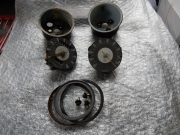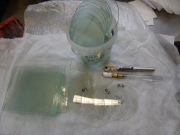 Depending on the kind of covers the paint is stripped off and after a base coat a fresh coat of paint is applied. Smith’s meters are white with a sea green surface inside and gloss black on the outside. The Nippon-Denso has an inner and outer shell, often also given the colors sea green, white and gloss black on the outside after a restoration.
Depending on the kind of covers the paint is stripped off and after a base coat a fresh coat of paint is applied. Smith’s meters are white with a sea green surface inside and gloss black on the outside. The Nippon-Denso has an inner and outer shell, often also given the colors sea green, white and gloss black on the outside after a restoration.
 The mechanism. After disassembly of the mechanism the parts are cleaned, checked on damage and fitted with different greases, depending upon the application. The mending of the needle damping requires extra attention; this is also done with the correct amount of special grease. After assembly the meter is tested on all functions, sealing lacquer is applied and the instrument is placed back. New rubbers are often needed. Meters which are riveted require more attention as the rivets will be replaced by screws. Drilling out and tapping thread, matching the screws are the extra jobs. Lenses are cleaned with “anti-condense”, the rim is fitted. The meter is ready for years of functioning.
The mechanism. After disassembly of the mechanism the parts are cleaned, checked on damage and fitted with different greases, depending upon the application. The mending of the needle damping requires extra attention; this is also done with the correct amount of special grease. After assembly the meter is tested on all functions, sealing lacquer is applied and the instrument is placed back. New rubbers are often needed. Meters which are riveted require more attention as the rivets will be replaced by screws. Drilling out and tapping thread, matching the screws are the extra jobs. Lenses are cleaned with “anti-condense”, the rim is fitted. The meter is ready for years of functioning.